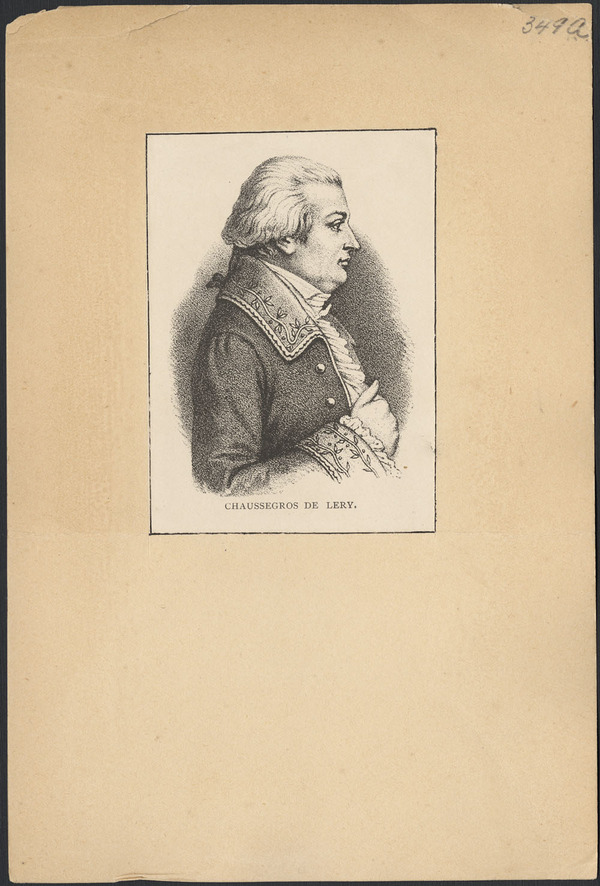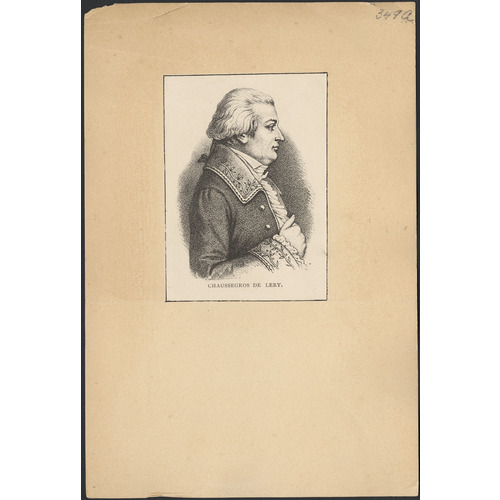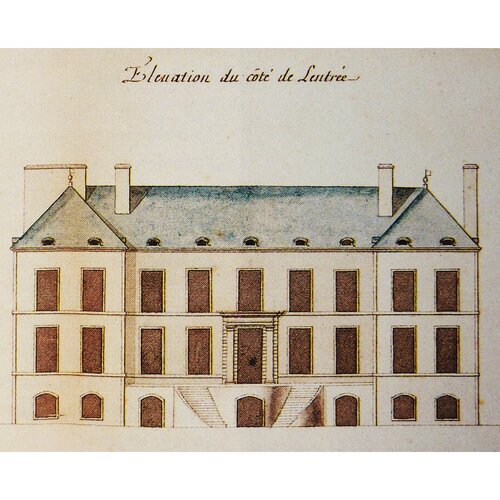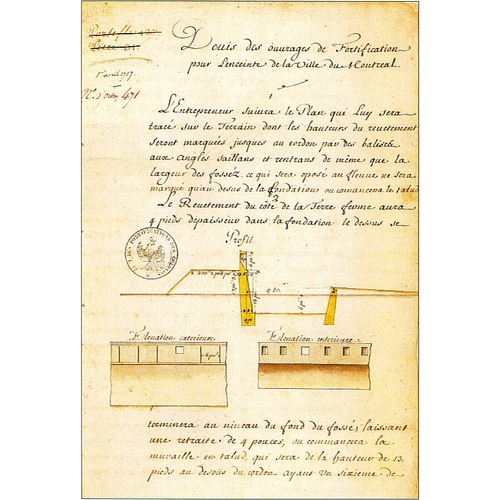CHAUSSEGROS DE LÉRY, GASPARD-JOSEPH (baptized Gaspard), army officer, engineer; b. 3 Oct. 1682 at Toulon, France, son of Gaspard Chaussegros, an engineer, and Anne Vidalle; m. 13 Oct. 1717 at Quebec, Marie-Renée, daughter of René Legardeur de Beauvais, by whom he had at least ten children, including Gaspard-Joseph*; d. 23 March 1756 at Quebec.
Gaspard-Joseph Chaussegros de Léry was trained in military engineering, probably by his father. Although he was never admitted to the engineer corps, he appears to have done extensive drafting in his youth and to have served in an engineering capacity in the French army. He participated in the siege of Turin, Italy, in 1706 as aide-de-camp to the Marquis de Vibraye; took part in the abortive attempt to land James, the Old Pretender, in Scotland in 1708; and was subsequently commissioned infantry captain in the Régiment de Sault. In 1714 he finished a long manuscript, never published, entitled “Traité de fortification divisé en huit livres.” In 1716, now in the department of Marine, he was sent to Canada to prepare plans of existing fortifications at Quebec and to recommend those required to protect the city from attack. Eventually his mission led to a permanent appointment as chief engineer, a post he held until his death 40 years later.
The public works for which Chaussegros was responsible included fortifications at Quebec and Montreal; the forts of Niagara (near Youngstown, N.Y.), Chambly, Saint-Frédéric (Crown Point, N.Y.), and Sault-Saint-Louis (Caughnawaga, Que.); the governor’s pavilion of the Château Saint-Louis at Quebec; design of the façade of Notre-Dame church at Montreal; repairs to the bishop’s palace at Quebec; designs for a “palais de justice” at Trois-Rivières; studies of a canal from Lachine to Montreal; consultation with respect to the Saint-Maurice ironworks and the mines in the region of Baie Saint-Paul; and plans for shipyards and drydocks on the Rivière Saint-Charles at Quebec.
Any attempt to assess the quality of Chaussegros’s achievements must take into account the attitude of the court at Versailles toward the work he was sent to do. The council of Marine in 1716 did not consider the resources of Canada vital enough to justify crown expenditures on their defence comparable to the moneys being spent on Île Royale (Cape Breton Island), for example, at the same time. The inhabitants, the wealthy religious orders, and the Domaine d’Occident should be prepared to share the cost. The policy changed little during the ministry of Maurepas from 1723 to 1749: the court was sparing in its contributions to the fortifications of Canada; and even in wartime, in 1746, Maurepas reasoned that to leave Quebec relatively unfortified would be a deterrent against Anglo-American invasion! The enemy would fear the consequences of having no winter refuge after the departure of the last naval vessels before freeze-up. In any event, between 1715 and 1752 the military engineers reputed to be the best in France – those who had been admitted to the corps according to standards laid down by its former head, Sébastien Le Prestre de Vauban – were not sent to Canada. The same council of Marine that dispatched Jean-François de Verville* to Île Royale was content to assign Chaussegros de Léry to a similar role in Canada. Nor could the connections that the latter apparently had with relatives of the king obtain for him an appointment in the engineer corps in France, which depended more on merit than did appointments in other branches of the French forces. He made unsuccessful overtures for such an appointment in 1729 and again in 1738.
Yet the evidence suggests that, although he may not have been outstanding as a military engineer, he was versatile and imaginative. During the years 1726–28 he proposed a rival French post close to Oswego on the south shore of Lake Ontario. He advised in 1733 against attempting a Lachine canal because the amount of rock which would have to be excavated by blasting would make the cost prohibitive. (His report does not indicate whether he was aware that Gédéon de Catalogne* had already discovered this difficulty in 1700.) He invented machinery and techniques for laying siege to Indian forts of a type encountered by troops from Louisiana. He analysed the potential productivity of the Saint-Maurice ironworks with particular reference to the use of waterpower for operating machinery. He offered suggestions regarding the location of shipbuilding yards at Quebec. He proposed a road from the Richelieu to Montreal to reduce the cost of freight, normally transported by water down the Richelieu and up the St Lawrence. He advocated a defensive strategy for Quebec which would have included not only a fairly large garrison inside the town, but a mobile force outside that could be rushed to trouble spots during a siege. He laid great emphasis on the use of fire-ships in order to repulse any British fleet that might venture up the river to attack the capital. He offered advice on retaking Louisbourg, Île Royale, and improving its defences.
The shortcomings of Quebec’s fortifications about the time of his death cannot all be laid at the door of Chaussegros de Léry: he had inherited bad work and had had to follow indifferent policies. Nevertheless, and even if from 1752 the court was depending on the advice of Louis Franquet, the extensive works Chaussegros had constructed during the war years from 1746 to 1749 were quite defective. Exterior works, which would have protected the escarp from direct fire and from escalade, were almost nonexistent. And there was no ditch. Although an analysis by Bernard Renau d’Éliçagaray, senior engineer at the department of Marine, had pointed out the need for one just before Chaussegros’s departure for Canada in 1716, the latter told Charles de Beauharnois in 1745 that it was impossible to blast one out of the rock. Franquet, examining the site seven years later, said that on the contrary it could have been done. Of course, it would have had to be done before the escarp was constructed. Furthermore, Chaussegros had provided for few embrasures in the faces of the bastions overlooking the Plains of Abraham: in his “Traité” he had written that only sorties by the besieged could destroy attacking batteries; and he believed in using defensive artillery chiefly for flanking and enfilading fire. In spite of all this, Chaussegros reported proudly to the minister, Antoine-Louis Rouillé, in October 1749 that “this town is fortified in the modern style, the fortification is well flanked, it will be well equipped for war.”
At Montreal, by virtue of a cost-sharing arrangement among the seigneurs (the Sulpicians), the inhabitants, the Domaine d’Occident, and the crown, the stockade was replaced during Chaussegros’s time by a masonry enceinte. The most that can be said in its favour is that it presented an appearance of permanence which befitted the second town of the colony. In 1760, it was considered quite unfit to withstand bombardment. Chambly was a well-constructed fort, safe against everything but cannon, but the defences of Fort Saint-Frédéric were subsequently condemned for being badly laid out on the ground and consequently being badly constructed. Chaussegros had left most of the supervision of Saint-Frédéric to his eldest son, Gaspard-Joseph, whose engineering competence he had misjudged. The son resigned his post as an assistant engineer in 1748. Fort Niagara, however, proved its worth by withstanding a siege in 1759 for 20 days.
Most 18th-century French military engineers were trained in the basic principles and practices of civil architecture. With some exceptions, few of them were really creative architects. They could reproduce the barrack blocks, garrison churches, and military hospitals common to fortress towns in France, and these were by no means ugly. They could even design colonial “chateaux” and intendants’ “palaces,” provided little originality was demanded. According to Ramsay Traquair*, Chaussegros was no exception. Writing of his work on the old church of Notre-Dame in Montreal (1722–1830), Traquair says, “If the front of Nôtre Dame is to be taken as a good example of his quality as an architect, his knowledge and designing abilities were very slight indeed.” Yet Chaussegros prepared all the plans, sections, and elevations for the second cathedral church at Quebec (built with little support from the court), as well as undertaking the work for the repairs on the Château Saint-Louis and renovating the intendancy after the departure of Claude-Thomas Dupuy*. He also designed jails and other utilitarian structures.
As a technical administrator, Chaussegros de Léry was variously regarded. Philippe de Rigaud*, Marquis de Vaudreuil, with whom he differed strongly over the renovations to the Château, condemned him, even implying that he was a liar; Dupuy ignored him; Beauharnois commended him and listened to his counsel; Gilles Hocquart* did the same until Chaussegros tried to point out the shortcomings of Hocquart’s plans for the Quebec shipyards; Governor Duquesne* damned him by faint praise; and François Bigot*, drawing attention in 1748 to poor accounts relating to Fort Saint-Frédéric, complained that the chief engineer was not reporting to the intendant, adding that in any event he ought to be retired because of old age. On two occasions at least, the minister suspected Chaussegros of collusion with contractors for personal profit, in 1730–31 and again in 1748–49, and had investigations made; but nothing was proved. In any event, officialdom commonly suspected this of engineers, in France as well as in the colonies. On the other hand, there are instances of Chaussegros’s seeking methods of saving costs for the crown: he refused to countersign the extravagant renovations instigated by the Marquise de Vaudreuil [Joybert*] in 1723–24; he sought ways of making the intendancy more fireproof by dismantling much of the woodwork installed by Dupuy, without wasting the materials; and he devoted considerable attention to the quality of a newly discovered Canadian slate which might have obviated the expense of importing French slate for the roofs of public buildings.
Chaussegros had a hot temper, which officials at court put down to his being a Provençal; and he was at least as conscious of status as his contemporaries were. His career problems may have stemmed from a failure to realize his own limitations. He importuned for 25 years before receiving the cross of Saint-Louis in 1741; he clamoured for recognition of what he considered to be his superior position as chief engineer. Before 1724 he was asking for the same title as Verville’s in Île Royale. In 1749 he pointed out bitterly that he had been paid, over the years, little more than one-third of Étienne Verrier’s salary in the same colony before its surrender in 1745. Not only did he oppose Franquet’s plans for altering the fortifications of Quebec, but threatened to refuse to carry them out. Only his death in 1756 obviated his forced retirement. As late as 1754 he was asking for the special honour of being named first engineer of the department of Marine, by virtue of his long and faithful service. The Chaussegros de Léry papers at the Archives Nationales du Québec contain letters from the Comte de Toulouse, from Philippe, Duc d’Orléans, and from the Duc de Penthièvre, acknowledging receipt of his, expressing their affection for him and his family, and promising to do all they can to assist him in his career. As ministers changed, he sought assurance that he could depend on whatever patronage was available. Yet when Maurepas coldly told him in 1738 that for admission to the engineer corps Chaussegros would have to apply, himself, to the Marquis d’Asfeld – implying that he, Maurepas, could not help him – Chaussegros replied that he preferred to remain in the colony under those circumstances, and protested his personal loyalty to the minister.
Chaussegros de Léry made a good marriage and established himself among the leading families of the colony. In legal actions in 1747 he successfully defended his children’s claims to the inheritance of their maternal grandfather, René Legardeur de Beauvais. He married one of his daughters, Louise-Madeleine, to Michel Chartier* de Lotbinière in 1747 and another, Marie-Madeleine-Régis, to Louis Legardeur* de Repentigny in 1750. Through his sons, he established a dynasty in Canada and in France that became distinguished in both the military and the civil fields.
Having raised a large family, he was not exceptionally wealthy, but at his death he possessed two lots in the town of Quebec, one in Rue Sainte-Famille purchased in 1726 from the seminary, on which his house was located, the other granted to him in 1732. Also, he possessed the seigneury on the Richelieu, granted in 1735, with a frontage of two leagues and a depth of three, extending from the limit of the seigneury of Longueuil northwest toward Lake Champlain. He owned a black slave, male, about 25 years of age, valued at 1,200 livres. The funeral expenses of Chaussegros de Léry amounted to 1,016 livres, 15 sols.
The historical legacy of Chaussegros de Léry consists of maps, plans, and papers concerning fortifications, public buildings, harbour facilities, and urban planning. His models of the fortifications of Quebec (1720) and of Montreal (1721), which long reposed in the Louvre, disintegrated in Paris during the 19th century. His “Traité de fortification” was recommended for publication in 1727 by Beauharnois, but Maurepas refused, ostensibly because of the cost, particularly of the illustrations. The real reason may have been that no senior officer of the engineer corps had a high opinion of its worth. Various manuals on fortifications were then appearing in print, some of them by distinguished French engineers, under their own names or under pseudonyms. Many other manuscripts on the subject may well have been refused.
The “Traité” has in common with some of its published contemporaries a tendency to condemn previous works on the subject; and it is curious that Chaussegros reproaches these predecessors for the very fault that Governor Duquesne found in him: a lack of practicality, too theoretical an approach. Duquesne appears to have been wrong to the extent that Chaussegros’s theory was faulty too. Various manuals published before and after the completion of his manuscript emphasized the adaptation of fortifications to the peculiarities of the surrounding terrain – and appear to have done so more effectively. It was his particular method of adapting structures to the terrain that was defective.
Taken in balance, Gaspard-Joseph Chaussegros de Léry deserves an important place in the history of New France as the architect of the 18th-century public buildings and fortifications in its towns, as well as of the forts which constituted its outer defences. His name is indelibly stamped on such historical sites as Quebec and Fort Chambly in Canada, and Fort Niagara on the United States side of the border.
Gaspard-Joseph Chaussegros de Léry’s manuscript entitled “Traité de fortification divisé en huit livres” is in PAC, MG 18, K2. AN, Col., B, 38–99; C11A, 36–100; D2C, 222/1, p.142 (PAC transcript); Section Outre-Mer, Dépôt des fortifications des colonies, Am. sept., nos.285–308, 395–429, 462–63, 470–89, 499–501, 506–13, 519–21, 530–32, 540–42. ANQ, Greffe de R.-C. Barolet, 15 mai 1756. PAC, MG 8, G24. Archives municipales, Toulon, État civil, Sainte-Marie de la Seds, 3 oct. 1682. Documents relating to Canadian currency during the French period (Shortt). Franquet, Voyages et mémoires sur le Canada, 174–76. Inv. des papiers de Léry (P.-G. Roy). Fauteux, Les chevaliers de Saint-Louis, 136. Le Jeune, Dictionnaire. P.-G. Roy, Inv. contrats de mariage, II, 30; Inv. ins. Prév. Québec, I, 138; Inv. jug. et délib., 1717–1760, I, 232, 240–41, 266, 271, 297; II, 47, 158; III, 114; V, 30, 37, 39, 190, 263–64; Inv. ord. int., I, 249, 286; II, 52, 55; III, 127; Inv. testaments, I, 116. Dubé, Claude-Thomas Dupuy, 153, 176, 277. Antoine Roy, Les lettres, les sciences et les arts au Canada sous le régime français (Paris, 1930), 140, 184. Stacey, Quebec, 1759. Stanley, New France. Ramsay Traquair, The old architecture of Quebec (Toronto, 1947).
Cite This Article
F. J. Thorpe, “CHAUSSEGROS DE LÉRY, GASPARD-JOSEPH (baptized Gaspard) (1682-1756),” in Dictionary of Canadian Biography, vol. 3, University of Toronto/Université Laval, 2003–, accessed April 30, 2025, https://www.biographi.ca/en/bio/chaussegros_de_lery_gaspard_joseph_1682_1756_3E.html.
The citation above shows the format for footnotes and endnotes according to the Chicago manual of style (16th edition). Information to be used in other citation formats:
| Permalink: | https://www.biographi.ca/en/bio/chaussegros_de_lery_gaspard_joseph_1682_1756_3E.html |
| Author of Article: | F. J. Thorpe |
| Title of Article: | CHAUSSEGROS DE LÉRY, GASPARD-JOSEPH (baptized Gaspard) (1682-1756) |
| Publication Name: | Dictionary of Canadian Biography, vol. 3 |
| Publisher: | University of Toronto/Université Laval |
| Year of revision: | 1974 |
| Access Date: | April 30, 2025 |






